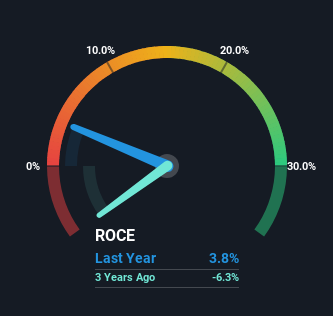- United States
- /
- Professional Services
- /
- NasdaqGS:UPWK
Upwork (NASDAQ:UPWK) Is Experiencing Growth In Returns On Capital
If you're not sure where to start when looking for the next multi-bagger, there are a few key trends you should keep an eye out for. Ideally, a business will show two trends; firstly a growing return on capital employed (ROCE) and secondly, an increasing amount of capital employed. Ultimately, this demonstrates that it's a business that is reinvesting profits at increasing rates of return. So on that note, Upwork (NASDAQ:UPWK) looks quite promising in regards to its trends of return on capital.
What Is Return On Capital Employed (ROCE)?
Just to clarify if you're unsure, ROCE is a metric for evaluating how much pre-tax income (in percentage terms) a company earns on the capital invested in its business. The formula for this calculation on Upwork is:
Return on Capital Employed = Earnings Before Interest and Tax (EBIT) ÷ (Total Assets - Current Liabilities)
0.038 = US$27m ÷ (US$1.0b - US$289m) (Based on the trailing twelve months to March 2024).
Therefore, Upwork has an ROCE of 3.8%. In absolute terms, that's a low return and it also under-performs the Professional Services industry average of 14%.
View our latest analysis for Upwork

Above you can see how the current ROCE for Upwork compares to its prior returns on capital, but there's only so much you can tell from the past. If you'd like, you can check out the forecasts from the analysts covering Upwork for free.
What The Trend Of ROCE Can Tell Us
We're delighted to see that Upwork is reaping rewards from its investments and is now generating some pre-tax profits. The company was generating losses five years ago, but now it's earning 3.8% which is a sight for sore eyes. In addition to that, Upwork is employing 170% more capital than previously which is expected of a company that's trying to break into profitability. This can indicate that there's plenty of opportunities to invest capital internally and at ever higher rates, both common traits of a multi-bagger.
In another part of our analysis, we noticed that the company's ratio of current liabilities to total assets decreased to 29%, which broadly means the business is relying less on its suppliers or short-term creditors to fund its operations. This tells us that Upwork has grown its returns without a reliance on increasing their current liabilities, which we're very happy with.
The Key Takeaway
To the delight of most shareholders, Upwork has now broken into profitability. And since the stock has fallen 23% over the last five years, there might be an opportunity here. With that in mind, we believe the promising trends warrant this stock for further investigation.
While Upwork looks impressive, no company is worth an infinite price. The intrinsic value infographic for UPWK helps visualize whether it is currently trading for a fair price.
For those who like to invest in solid companies, check out this free list of companies with solid balance sheets and high returns on equity.
New: AI Stock Screener & Alerts
Our new AI Stock Screener scans the market every day to uncover opportunities.
• Dividend Powerhouses (3%+ Yield)
• Undervalued Small Caps with Insider Buying
• High growth Tech and AI Companies
Or build your own from over 50 metrics.
Have feedback on this article? Concerned about the content? Get in touch with us directly. Alternatively, email editorial-team (at) simplywallst.com.
This article by Simply Wall St is general in nature. We provide commentary based on historical data and analyst forecasts only using an unbiased methodology and our articles are not intended to be financial advice. It does not constitute a recommendation to buy or sell any stock, and does not take account of your objectives, or your financial situation. We aim to bring you long-term focused analysis driven by fundamental data. Note that our analysis may not factor in the latest price-sensitive company announcements or qualitative material. Simply Wall St has no position in any stocks mentioned.
About NasdaqGS:UPWK
Upwork
Operates a work marketplace that connects businesses with various independent professionals and agencies in the United States, India, the Philippines, and internationally.
Undervalued with solid track record.
Similar Companies
Market Insights
Community Narratives



